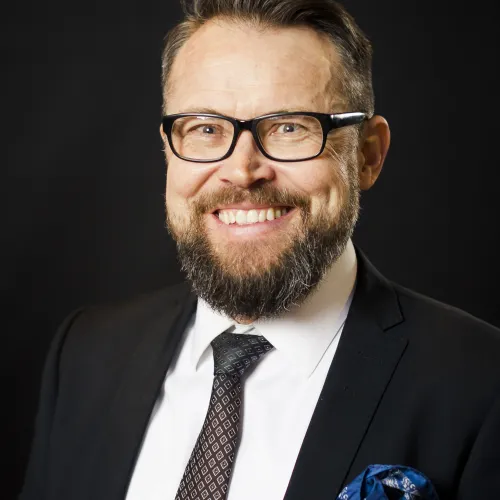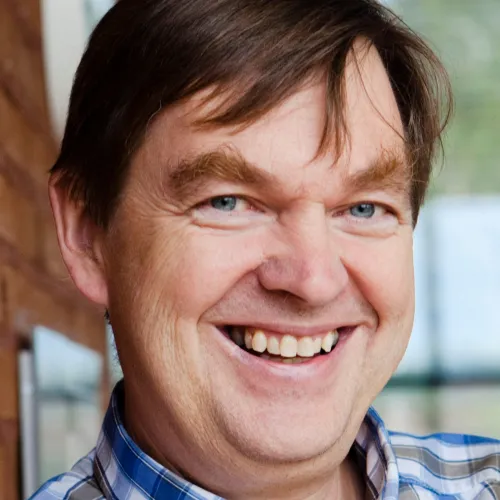Juha Pyrhönen, LUT's Professor in Electric Drive Technology, has a long research history in the field of energy efficient electrical machines. His long-term research interest in permanent magnet machines for wind turbines recently led to a new innovation, a liquid cooled permanent magnet electrical machine.
To reduce the size of the permanent magnet machines dramatically, Pyrhönen's group wanted to explore how a machine could be cooled with liquid instead of the traditional air. As a result of co-operation with numerous LUT research groups, a radically new machine saw daylight. LUT holds several global patents resulting from the project.
Aki Mikkola, LUT's Professor of Mechanical Engineering, describes the key benefits achieved in the new machine.
"Permanent magnets are typically the most expensive components in a machine. With an effective cooling system, a substantially smaller machine can give the same amount of torque, i.e. power. This results in significant cost savings. Cooling the machine's coils with water is more effective than air cooling, which is largely dependent on external conditions."
Mikkola mentions marine vessels as an example: the machines are located in the lower parts of the ship's body, where effective ventilation is challenging.
"The marine sector is also an example of a field undergoing a major technological change. Hybrid solutions or even fully electrical vessels are a growing trend, as it is already forbidden to dock at some ports using diesel engines."
Dropping weight saves costs in machine building
Pyrhönen's group asked Professor Mikkola and his colleagues in mechanical engineering to build a prototype to test the intended water-cooling technique. The requested prototype was larger than the usual lab-scale prototype, and laminated steel structures were used to build the body. By using laminated steel structures, no welded structures were needed, and the total weight of the machine is about half of the equivalent, traditionally constructed machines.
"In machine building, weight and price go hand in hand: the heavier the machine, the bigger the construction costs. The traditional way is to weld large pieces of metal together. Welded structures are, however, always exposed to the risk of fatigue, and need to be monitored. When a machine is used in applications like wind turbines, reducing weight as well as avoiding fatigue and cracks are critical,", Mikkola elaborates.
During the construction, it was discovered that the stacked steel structures also functioned as excellent damping structures in the machine. According to Mikkola, this was "a complete accident".
"This is one of the best things in being a researcher: new findings and breakthroughs can result from lucky coincidences. We were surprised to discover that the laminated steel structures absorbed the vibrations caused by the machine's motor very effectively."
Luck can sometimes speed things up, but creating radically new technology is slow in nature, reminds Mikkola. A time span of ten years from research launch to market entry as a finished product is no exception.
"Basic research and persistency are always needed. Experienced colleagues such as Juha Pyrhönen might not draw attention to themselves, but they contribute a lot to both the science community as well as industrial applications."
Watch the video with LUT's research engineer Scott Semken explaining the features of the liquid cooled electrical machine.
LUT's IPR portfolio to boost business
LUT has a long history in protecting intellectual property rights. There are annually around 50 innovations potential for patenting, and around 20 of these result in patent applications. LUT's IPR portfolio is managed by Green Campus Open, the research-to-business accelerating unit of the university.
"Our portfolio consists of globally protected patent families from LUT's key research areas, especially in the fields of energy, electrical engineering, environmental technology and process engineering. Patents are both sold and licensed out. Our main goal is to support the international competitiveness of the Finnish industry sector", says Lauri Haiko, director of Green Campus open.
Haiko continues that LUT's IPR portfolio benefits both new start-ups as well as established industrial companies. New solutions are typically discovered in cross-disciplinary research projects, and they often have potential in solving other challenges than the one originally addressed in research.
"Sometimes the application potential is discovered very fast when discussing with the companies. Scanning through the patent database is unlikely to give same understanding. We're happy the present research results and the IPR involved to companies or anyone planning a new business venture. Our job is to speed up the technology transfer from portfolio into applications."
"The video about the liquid-cooled electrical machine immediately launched discussions with a few potential companies, who are interested in commercializing the technology", Haiko ends with a recent example.
Lisätietoja:






